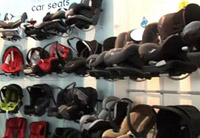Choosing Child Car Seats

There are very many different types of child car seats available, so take your time when choosing.
The child car seat you choose, must:
- Conform to the United Nations standard, ECE Regulation 44.04 (or R44.03) or to the new i-size regulation, R129. Look for the 'E' mark label on the seat.
- Be suitable for your child's weight and size
- Be correctly fitted according to the manufacturer's instructions.
Before You Buy
- Check the Types of Child Seats section of this website to see what type of seat is suitable for your child's weight and height.
- Take time to look through manufacturer's catalogues and websites, and shops that sell child car seats to assess a range of seats.
- Magazines, such as "Which?", "What Car" and "Mother and Baby" conduct tests of child car seats and provide useful recommendations.
- Check the European New Car Assessment Programme (EURO NCAP) website (www.euroncap.com) to see if your car model has been tested. The tests include a Child Restraint System installation check in which a selection of popular child restraints is installed to assess how well they can be fitted in the vehicle. If possible, choose a child seat that has scored well in their tests.
- Think about how you will use the seat. For example, if you will be constantly taking it in and out of the car, a lighter weight seat, or a seat with a base that stays in the car, might be preferable. If you do a lot of long journeys, a seat that reclines may be more comfortable for your child and help him or her sleep.
- Check that the seat(s) you are considering will fit your car(s).
When Buying
- Ask the retailer if the child seat is suitable for your child and car. Try to find one who will help you try the seat in your car before you buy it.
- Ask whether they have staff trained in choosing and fitting child car seats, and try to make sure you are advised by a staff member who has been trained.
- If this is not possible, make sure that you can return the seat, and replace it or get a refund, if it is not suitable.
- Avoid buying a child seat online, unless you are sure that it is suitable for your child and will fit your car.
- Check that the seat meets the United Nations standard Regulation 44.04 - look for the 'E' mark or it meets the new i-size standard (R129).
Second-hand Seats
Do not buy a second-hand seat, you cannot be certain of its history (it may have been involved in a crash) and even if it looks fine, it may have internal damage that is not visible to the naked eye. The instructions are often missing with second-hand seats.
Second-hand seats are likely to be older and not designed to current standards. This means that they will provide less protection for your child.
Only accept a child seat from a family member or friend, if you are absolutely certain that you know its history, it comes with the original instructions and it is not too old.
